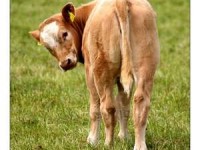Coccidiosis is caused by single-celled parasites known as coccidia.
There are several species in cattle, not all of which cause disease. The species that cause disease are primarily found in the large intestine, and the diarrhoea results from damage to the cells lining it. Coccidiosis is particularly common in calves between three weeks and six months of age. Cattle become infected when placed in environments contaminated by older cattle or other infected calves. This can happen either indoors on bedding, or outdoors around drinking or feeding troughs. In order for the coccidial oocysts (the egg stage of the parasite) to become infective they require warmth and moisture.
Poor hygiene, high stocking density, poor health and poor nutrition will all contribute to a calf picking up the parasites and subsequent disease. Symptoms
Symptoms are not always specific to coccidiosis.
- Diarrhoea (often very watery)
- Depression
- Loss of appetite
- Weight loss Dysentery (passing blood stained faeces)
- Death is rare.
Infections that fail to produce diarrhoea can, nevertheless, result in reduced growth and weight gain. This sub-clinical infection is very common.
Treatment
In most cases calves will recover without treatment. Treatment is better given to in-contact animals that have not yet started showing signs, or to combat secondary infection.
Prevention
To achieve effective control of coccidia, good management and hygiene is vital. Young susceptible animals should be kept as clean and dry as possible. Feeding and watering equipment should be cleaned and protected from fecal contamination. Avoid feeding cattle on the ground, especially calves, so manure does not contaminate the feed. Excessive moisture in pens should be drained, and dry bedding should be provided. Use pastures that are well drained, and avoid forcing animals to graze down to the roots of the plants so they do not eat large numbers of parasites. Try to keep grazing to a minimum in areas where cattle congregate (e.g. by water). Whenever possible, infected animals should be isolated as soon as possible to avoid exposure of infected manure to other cattle. In some places, medication can be placed in the water or feed to prevent infection.
– See more at: http://www.thecattlesite.com/diseaseinfo/206/coccidiosis/#sthash.o2HT3ynK.dpuf

